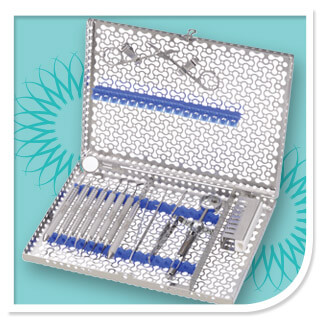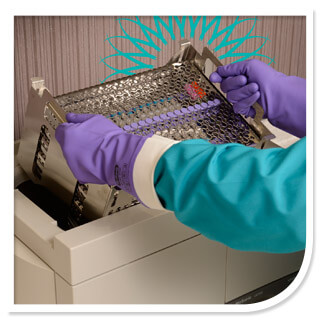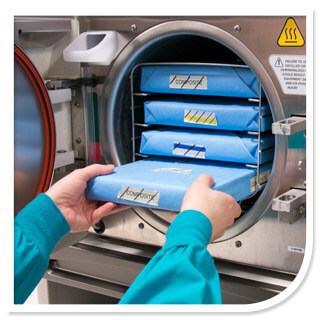Blog
5 Ways Instrument Management Keeps Dental Practices Competitive in 2018

Is your practice as efficient as it could be?
In the modern world of dentistry, the status quo is no longer an option. To grow and be successful, dental professionals need to continually improve their practices by asking themselves, “What can we do better?” And as they look to the coming year, there are certain areas of improvement they all want to focus on.
In general, practices of all types want to drive efficiency and productivity through their processes, while also leveraging contemporary technology and best practices to deliver optimal patient care and safety.
To do this, it can be tremendously helpful to know how their practice stacks up against their peers. What areas of dental practice management should clinicians focus on improving in 2018, to build the strongest practice possible?
 We wanted to know. So, we asked.
We wanted to know. So, we asked.
Along with our partner, Dental Products Report, we surveyed dental professionals, asking them about the biggest challenges within their practice. We also found out what the top dental practices are doing to save time, improve compliance, and maximize efficiency.
The full study results are available in our new e-book, “The Journey to Better: The Top Areas That Must Be Addressed.”
One way in which dental professionals can launch that journey is by standardizing their instrument management and organization. The right instrument management system (IMS) can provide that edge practices seek and can surprisingly address many of the office’s goals and issues. IMS standardizes and combines the cleaning, sterilization, storage, and organization of instruments in one integrated cassette system – and it might just be a practice’s secret weapon to outpace the competition with a management strategy that maximizes both quality of care and practice efficiency.
Challenge #1: Refining Time Management
It may seem like there’s never enough time in a day. The good news is that being too busy usually means business is good. The bad news is that sometimes being busy means it becomes challenging to get everything done — and that can lead to other problems.
Since time is one of the most important facets of managing a contemporary practice, dental professionals need to look hard at those functions that could benefit from optimization. For many dental practices, instrument reprocessing is that time stealer. Clinicians who are forced to delay patient appointments while staff wait for instruments to be sterilized or waste time searching for the right combination of instruments and exam kits would agree.
Savvy practices, on the other hand, take steps to reduce processing time without compromising quality or safety, giving them more time to spend with patients.
How can IMS help? Imagine if staff could save an hour or more each day. Procedural setups in cassettes shave five to ten minutes off each procedure — a time savings that adds up quickly. With IMS, a single system combines cleaning, sorting, autoclaving, and prepping of instruments. Then when it’s time for patient prep, all the needed instruments are ready to go.
“I know all my instruments are right there [in the cassette] and that I’m not getting doubles [of instruments] in some [packs], while some [instruments] are missing in other packs.” — Tiffany Ulanowski, RDH with Drone Dentistry & Prosthodontics
 Challenge 2: Ensuring Compliance
Challenge 2: Ensuring Compliance
There are strict OSHA standards and CDC guidelines that surround instrument cleaning and sterilization, and practices that don’t comply risk being shut down, especially when an infection control breach occurs. Finding a trusted solution is hard. Finding one that adheres to all industry guidelines and regulations for transporting and reprocessing instruments is even harder.
Understanding how peers meet this challenge can be particularly helpful, and modeling a solution after the one used by top dental practices is a smart way to stay on the right side of regulatory bodies.
How can IMS help? Secured cassettes significantly reduce the need for staff to handle contaminated tools. The structured loading process for cassettes reduces the chance of overloading cleaning and sterilization equipment while helping to ensure every instrument will be properly cleaned and sterilized, every time.
“A cassette on a bracket table that is unwrapped immediately prior to patient care offers comfort, confidence, and an air of professionalism to the dental patient. It exhibits that infection control is a high priority for a dental practice in both perception and reality.” — Dr. Marie Fluent, DDS, OSAP Educational Consultant
Challenge 3: Increasing Staffing Efficiencies
Busy and successful practices require well-organized, smooth-running staff operations — which often means maximizing personnel resources throughout the day.
Hiring more staff may not be the most effective solution. Implementing efficient ways for existing staff to do their jobs is usually a more practical and impactful approach.
How can IMS help? Traditional instrument processing and prep work are time-consuming and take staff away from patient care and other essential tasks. But with IMS, dentists and hygienists know their instruments will always be exactly how and where they need to be – no lost or misplaced instruments and no doubles – keeping clinicians where they need to be. And that’s in front of patients, providing the quality services they deserve.
“Using the cassettes has really benefited our office from the time-savings standpoint. We can get all of the unsterilized instruments out of the room quickly. When we go into the sterilization unit, we can go directly into the sterilization protocols. It saves time for the staff, and that’s important to make sure the staff isn’t staying late to turn rooms over and redo the sterilization after hours. It’s probably the best thing I’ve bought in my practice.” — Dr. Michael Drone, Drone Dentistry & Prosthodontics
 Challenge 4: Promoting Safety
Challenge 4: Promoting Safety
Dealing with sharp instruments throughout the day can present big risks to even the most careful dental professionals. With approximately 1,000 sharps injuries daily among healthcare workers, each of which can cost dentists between $500 and $3,000, accidental injuries put both profits and staff at risk.
How can IMS help? Because it uses a secure cassette system for storing and transporting instruments, IMS virtually eliminates the risk of instrument-related injuries.
“I think for staff it’s a very easy sell. Who wouldn’t like spending less time cleaning dirty instruments and repacking clean one? Who wouldn’t appreciate less of an opportunity to get their finger poked by a sharp instrument?” — Dr. Jeff Wojno, Always There Dental Care
Challenge 5: Improving Profitability
Every company focuses on growing their bottom line, and dental practices are no exception. Anything that increases expenses — including overhead and supplies — has an impact on profits.
For many practices, this often means protecting the investment they make in their instruments. When instruments can easily cost $20 to $100 each, every aspect of handling these instruments should be carefully assessed.
For example, traditional cleaning processes are notoriously rough on instruments. When instruments are cleaned manually, they can be dropped, damaged, lost, or even thrown away by accident. Top dental practices know that developing better cleaning and handling processes can easily provide a fast return on investment.
How can IMS help? IMS securely contains each instrument during the cleaning process, which can increase the useful lifespan for each one while reducing the need to replace them due to damage. Best of all, many IMS users recoup their investment expenses quickly — sometimes in less than a month — providing an always-appreciated boost to the bottom line.
“The instruments are kept nice. The mirrors aren’t scratched up. The probes are straight. Our explorers are sharp. We’re very delicate with our instruments, and we’re taking good care of them like we would take care of our patients.” — Gina Handrigan, RDH at Always There Dental Care
What Will Your Practice Achieve This Year?
Often, the best way to gauge where to start improving dental practice management is for clinicians to see what their peers are doing.
When a practice’s goals include improving safety and increasing efficiencies while also enhancing delivery of care, IMS can offer dramatic results. Staff can complete pre- and post-visit practices faster, freeing up time to spend with each patient and still have time to see more patients in a day.
The result? A patient-focused, efficient dental practice that stands among the best.
“We have a faster turnover rate [with IMS], and because of that, we have been able to see more patients and have enjoyed steady month-to-month growth.” — Dr. Izzy Naem, Floss & Co.
Looking for more information?
If you’re ready to learn more about how IMS can improve your dental practice management, streamline service delivery and provide the best clinical care, download our e-book, “The Journey to Better: The Top Areas That Must Be Addressed.”
If you’re ready to discuss how IMS can impact your individual practice, click here to request an in-office IMS Consultation.

